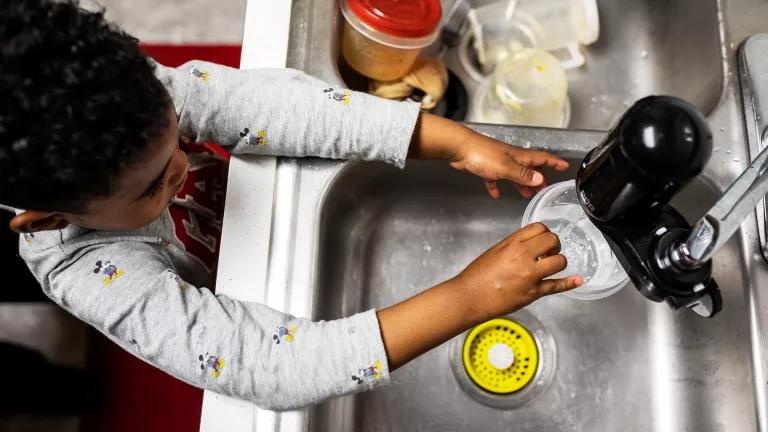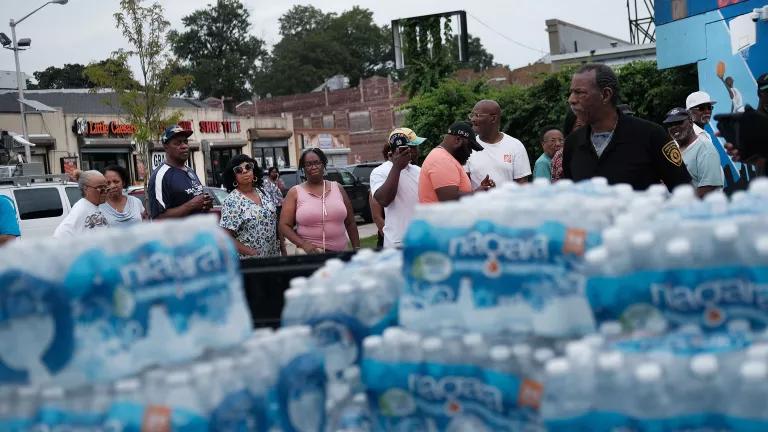Newark’s Lead Crisis Continues: Even Higher Levels in 2019
The first few months of 2019 have brought disturbing news for Newark residents—skyrocketing levels of lead in drinking water. Since the start of the year, more than 10 percent of Newark’s reported drinking water samples have exceeded 66.9 parts per billion (ppb) for lead, more than four times the 15 ppb federal action level.

Bryce Thomas fills a cup with water from the kitchen faucet in his Newark home.
Demetrius Freeman for NRDC
Newark’s rising lead levels
The first few months of 2019 have brought disturbing news for Newark residents; skyrocketing levels of lead in drinking water. Since the start of the year, more than 10 percent of Newark’s reported drinking water samples—called its “90th percentile”—have exceeded 66.9 parts per billion (ppb) for lead, over four times the 15 ppb federal action level. During the same period, individual homes reported lead in drinking water at levels of 202, 212, 544, and 953 ppb. And during the last completed six-month monitoring period, which closed in December 2018, City-wide lead levels reached 47.9 ppb, with 44 percent of samples reporting lead at levels above 15 ppb. While these recent levels demonstrate an alarming spike, Newark’s elevated lead levels are not new. Newark’s drinking water has far exceeded the 15 ppb federal action level for at least the last four six-month monitoring periods: reporting 27 ppb (June 2017); 26.7 ppb (December 2017); 17.8 ppb (June 2018), and 47.9 ppb (December 2018).
Newark’s water lead levels are not borderline; they are among the highest of any water system serving more than 100,000 people across the country. Newark’s lead levels far exceed those reported in virtually all other cities that have battled lead-contaminated drinking water.
While Newark’s sustained, elevated lead levels are alarming, its publicly reported levels—posted on New Jersey Drinking Water Watch—likely underreport actual lead levels. This is because Newark reports only some of its sampling results—those that qualify for its legally-required sampling pool—online. Some samples requested by customers, which have reported results that are statistically higher than samples from Newark’s sampling pool, are excluded from public reporting. As a result, the samples reported on New Jersey Drinking Watch exclude many extremely elevated results, skewing the reported levels downward.
The 15 ppb lead federal action level is not a safety indicator. It is merely the level at which water systems are required by federal law to take action to notify and protect residents. Experts agree there is no safe level of exposure. The American Academy of Pediatrics recommends that lead not exceed 1 ppb in school water fountains. And while the World Health Organization has established a provisional guideline of 10 ppb for lead in drinking water, it recognizes that that level may not be protective of health. Pregnant women and children are especially vulnerable; even low levels of lead are associated with serious, irreversible damage to children’s developing brains and nervous systems. These effects include lower IQ scores and academic performance, inattention, impulsivity, aggression, and hyperactivity. Exposure to lead is also associated with miscarriages in pregnant women, as well adverse cardiovascular and kidney effects, cognitive dysfunction, and elevated blood pressure in otherwise healthy adults.
Elevated lead levels persist in the eastern half of Newark
The Newark Education Workers Caucus (NEW Caucus) and NRDC have long urged Newark to acknowledge that the City’s lead problem affects residents in the eastern portion of the City. But the City continues to insist that those residents served by the Wanaque treatment plant—including the East Ward and parts of the North Central and South Wards—are unaffected, despite its admission that water from the troubled Pequannock Plant is “blending” into areas served by the Wanaque plant, including the East Ward. In recent legal filings, Newark claimed “[t]here is no lead problem in the Wanaque, even in the alleged blending areas.” But the data show otherwise.

City of Newark, NJ – Residential Sampling Results for Lead in Drinking Water, January – March 2019
As shown above in the map, in the most recent monitoring period, currently underway, numerous samples from the Wanaque service area exceed the 15 ppb federal action level, currently reaching 23 parts per billion at the 90th percentile. Individual households are reporting levels at 242, 100, 88, 72.5, and 52.6 ppb in the Wanaque service area. While these levels are concerning—particularly given Newark’s refusal to provide water filters and other resources to Wanaque service area residents—they are not new. In 2014, the City reported 90th percentile lead levels of 19 ppb in the Wanaque service area. Two years later, in 2016, lead levels above the federal action level were found in the drinking water of nearly half of Newark’s public schools, including at least three—Wilson Avenue School, South Street School, and East Side High School—located in the East Ward. Lead in drinking water at Wilson Avenue School, an elementary and middle school, reached 193 parts per billion. The data are clear: Newark’s failure to address the lead contamination of its drinking water affects residents in the Wanaque service area, including the East Ward.
What’s causing Newark’s lead problem and what can be done?
The cause of this crisis? For years, Newark has failed to treat its water as required to prevent the corrosion of lead pipes into Newark’s drinking water. Without the legally-required water treatment, Newark’s water corrodes leaded materials in the City’s water distribution infrastructure, including the lead service lines that carry water to homes and businesses from water mains, and lead plumbing within residents’ homes. As a result of this corrosion, lead dissolves and lead particles flake into the water that flows through the pipes. That lead is delivered into the water that flows from residents’ taps.
Throughout 2017 and 2018, Newark denied NEW Caucus’s and NRDC’s claims that the City’s water treatment had failed. Newark officials insisted that the water was safe, even months after its own consultant reported that legally-required treatment had been “relatively ineffective” between 1992 and 2017. Finally, in October 2018, Newark officials acknowledged that its water treatment is not effective, and announced plans to provide water filters to certain residents.
As a short-term solution, NEW Caucus and NRDC have asked the Court to require Newark to either provide residents with bottled water or expand its water filter program to cover all at-risk residents, and to make specific improvements to ensure residents receive the equipment and training they need to install and operate their filters in a health-protective way. In the long term, a much more comprehensive approach—including installation of effective optimized water treatment and expeditious full removal of lead service lines on an enforceable schedule, at no direct cost to residents—is needed.




